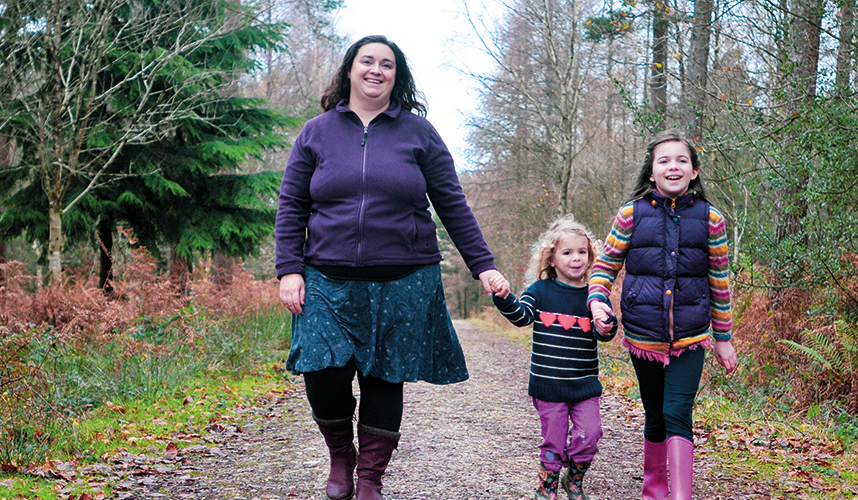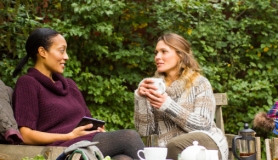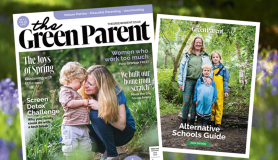Alot of discussion has happened in recent years about our children’s connection with the earth and nature. Forest Schools have popped up all over the place and more and more schools have dedicated areas for children to grow food or observe wildlife. Slowly but surely we seem to be realising that something has been lost along the way and we’re trying to give our children that connection again.
But what about us? How can we expect our children to feel connected and have a love of nature if we haven’t given ourselves the chance to also reconnect. This disconnection doesn’t exist only for our children, it’s been happening for generations, we are in need of nature just as much as them. Often the busyness of adult life can cause us to lose sight of feeling close to the earth.
Joseph Cornell talks about sharing our inner self with our children to feed their joy in nature and to help inspire them, but I believe it can go far beyond that and help us in ways we perhaps didn’t imagine. Not just gaining a deeper understanding and respect for nature, but we often gain a stronger feeling of responsibility towards the planet and the environment, our mental health can be improved and we can foster stronger relationships with our children.
FIND YOUR AWE
The simplest benefit of natural learning and reconnecting with nature is letting ourselves be in awe of it. It’s not just children that are allowed to be amazed by how bees go about their work, or how the seasons change the landscape. It’s not childish to look at the world in a simpler way, at its most basic level (which is often incredibly intricate and beautiful), in fact that deeper understanding and appreciation for nature is what will hopefully inspire and drive us towards the next benefit, the feeling or responsibility.
Connecting with nature, be it through growing our own food or going on long walks through the countryside will often help us gain an awareness of issues that perhaps we previously felt removed from. Suddenly after picking fresh kale from the garden we can truly connect with how much plastic food from the supermarkets is wrapped in, and those long walks might have litter scattered along them that is going uncollected. Once we make a personal connection to these issues we often find it easier to make changes towards protecting our environment on a local and global scale. Often it’s the children that notice these things more than adults, sadly many of us have almost become numb to issues that we feel we can’t do much to help with. Only when it’s a passionate nine year old demanding we collect litter or reduce our plastic waste do we feel that fire to get more involved.
GIVING BACK
Spending time outdoors, whether it’s a fresh walk by the sea on our own or pottering around in the garden with the kids can help when we’re feeling stressed. GP’s in the UK are now prescribing spending time outside for their patients! There are countless benefits to being outside (vitamin D, fresh air, natural light to name just a few) so it’s pretty obvious that reconnecting with nature is a great way of boosting our mental health. You don’t have to suffer with a complex mental health issue to deserve this, it’s important for us all to be mindful of how we’re doing and to look after ourselves. Connecting with nature is an easy way of giving back to ourselves.
By including our children in this journey back to nature, we can deepen our connection through them. The enjoyment of watching your child exploring rockpools, foraging for blackberries together, wandering through woodland talking with each other, it all works to strengthen not only our bond to nature but to our children. Having these simple but deep experiences and conversations with our children can help foster a stronger relationship with them. If we are openly sharing our ‘inner self’, giving our children a glimpse of who we really are, not as parents but as individual people, we are opening the door for them to do the same.
Some of my most memorable conversations with my daughter have been while lying in the grass together imagining what shapes we see in the clouds above, or while sitting around a campfire deep in the woods. What starts as a conversation linked to, or inspired by, nature can often morph into me sharing childhood stories or my daughter opening up about what’s on her mind.
“The next time you walk out your door, feel your feet connecting with the earth”
SHARING AS A FAMILY
For my family we’re connecting to nature in different ways. We spend time in our garden, whether we are all working on the same job, or I’m pottering around while the children play, just existing in the same space together can lead to some lovely moments. Often my nine year old will be eager to help plant up new seedlings while my four year old will be concentrating on collecting flowers or following some insects to see what they’re doing. It’s easy to connect with her by asking her to tell me what she’s found, young children love telling us about their world, and its often so inspiring for us to see the world from their point of view, seeing things we’d normally miss.
We were part of a natural learning home education group which met up weekly pre lockdown. Every week we started by sitting around a campfire, singing our opening song and then introducing ourselves and perhaps sharing how we’re feeling. Everyone is invited to talk including the youngest of children, and nothing is off limits so we are there for each other just as much for our children. We spent time on the land in various ways, whether its cooking a big soup or popcorn over the fire, building dens in the wood or simply letting the children play. Although we are all responsible for our own children, belonging to this community meant we often cared for other children as well, this doesn’t just mean that the closest adult picks up the fallen toddler for a hug, but it can also mean sitting with another child and talking about the fungi they’re so excited to have found or pointing out interesting things we’ve seen to the closest child. If you’re unsure of how to reconnect with nature, a great place to start is by finding a community like this who can help guide you, when we’re able to gather in groups again.
The important thing is to find your way back to nature in a genuine way, there’s no point going on a 10 mile trek if you hate long walks or starting a vegetable garden if you have no desire to grow your own food. By all means try out new things, but don’t push yourself to do things you don’t enjoy (I’m giving the long walks a miss, I much prefer sitting around a campfire). Children know when we are faking enthusiasm as a way to try and encourage theirs, if you’re willing to spend time in nature with your children do so in a way that feels right for you.
MORE INSPIRATION
WATCH talks that will give you a deeper understanding of where the wild things grow at ted.com/playlists/398/reconnect_with_nature
PLAY Find courses and nature explorations in Pembrokeshire at reconnectinnature.org.uk
Jean lives on the edge of Dartmoor with her husband and two daughters. When she is not writing she spends her time home educating her children and enjoying the Devon countryside
5 WAYS TO RECONNECT
Megan Roop is a retreat leader who guides women in living a more present, free, and connected life. Here are her five ways to get reacquainted with the earth
- BRING NATURE INDOORS - Buy some houseplants, keep a jar of fresh flowers, put a crystal on your desk, place a jar full of seashells and sand in your living room, or start a pinecone collection.
- WAKE UP WITH NATURE - Upon waking, open your window and stand in front of it. Look outside and take in all the beauty of nature. Breathe in the colours, shapes, textures and sounds. Notice the colour of the sky, the shapes of the clouds and the sounds of the birds. Allow the natural world to ground you into the here and now.
- MAKE CONTACT WITH THE EARTH - Go outside, take off your shoes and socks and sink your bare feet into the grass. If there’s snow or ice on the ground, then find a tree and place your palm on the trunk. You can even give it a big tree-hug if you’re feeling the love; just lean in and wrap your arms around it.
- PLAY IN THE DIRT - Tend to a veggie patch or an herb garden, play in the sand or make mud pies with little ones. Just as sinking your bare feet into the earth will ground you, so will digging into it with your hands.
- KISS THE EARTH WITH YOUR FEET - One of my favourite quotes from Thich Nhat Hanh reminds us to slow down and notice nature, “Walk as if you are kissing the Earth with your feet.” The next time you walk out your front door, feel your feet connecting with the earth, step by step.






